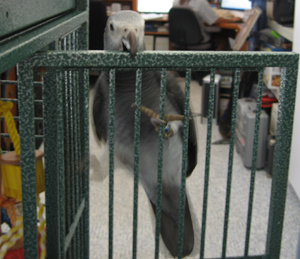African Grey Cage and Environment

African Grey Parrots are very sociable and require a lot of attention and interaction. Thus it is important to make sure that their cage and environment is more than adequate for their housing needs.
The cage is a safe retreat or haven for your African Grey Parrot. This is where the bird feels safe and secure, no different than what you feel when you walk into the door of your home. There is food to eat, water to drink and best of all toys to play with!
A suitable cage for an African Grey Parrot is at least 2 feet deep by 3 feet wide by 4 feet high (61 x 91 x 122 cm) and has a playpen top with a tray. African Grey Parrots are very active and need a lot of "out" time. It's important to make sure that there are toys both inside the cage and outside in the playpen area to keep your African Grey busy.
It is best to get a cage that has horizontal side bars to help these nimble climbers get their exercise as they climb up and down the sides. A cage with too few horizontal bars has shown to contribute to a lack of motivation and curiosity. You should avoid a round cage as converging bars can trap toes or feet. A square cage also provides more room for your African Grey Parrot.
The cage you select is going to be home to your African Grey Parrot for a long time, so don't skimp – obviously you want something that is going to last so make sure you check it thoroughly. When selecting your African Grey cage keep in mind the following:
- Quality of the cage –The bars of the cage should be too thick for the African Grey to bend and where the bars join should be smooth. No sharp edges, flaky finish or easy to disassemble. We're dealing with Einstein's here!
- Material of the cage – the cage should be made from noncorrosive metal. Powder-coated cages typically stand up best to the test of the African Grey Parrot's beak and are usually very safe. Other acceptable metals include steel, brass or chrome. Zinc, which is toxic to birds, are in shiny welded wire and hardware cloth and cages that have these substances should not be considered for your African Grey Parrot.
- Bars of the cage – There should be no openings or spacing between the bars large enough for your African Grey Parrot to put their head through or small enough for them to catch their toes. Typically, a good rule of thumb is the bars should be spaced about ¾ - 1 inch apart.
- Perches of the cage – the perches that come with the cage might need to be replaced. African Grey Parrots love to grip the perch and flap their wings so make sure that you have a variety of easily gripped sized perches available for their use. For them to be able to grip the perch the opposing long toes need to extend at the least a little more than halfway around.
- Trays and Grates – Make sure the trays and grates are removable so they are easily cleanable.
- Dishes – Stainless steel or ceramic bowls are easier to keep clean and last longer than aluminum dishes. If the cage comes with aluminum dishes, you should replace them.
The cage should be kept clean by wiping it down with detergent and water or a bird safe disinfectant solution. Newspaper seems to be the safest bedding as organic bedding can cause illness and death if ingested, also the dust associated with them can be harmful.
The location of the African Grey cage in your home is very important. African Grey Parrots are flock members and like to be where the action is. They need the human interaction and their curiosity to know what is going on makes the place where the cage is essential to their health and happiness. Most African Greys' cages seem to live in dining and living rooms, but remember not to expose the cage on all sides so they will still have a secure feeling when in their home.